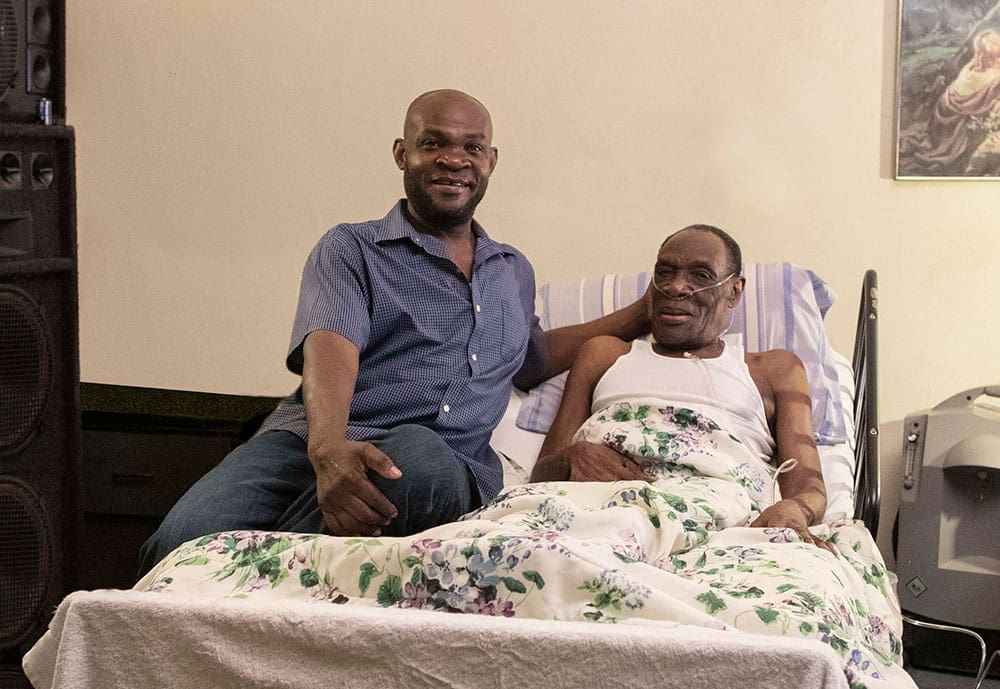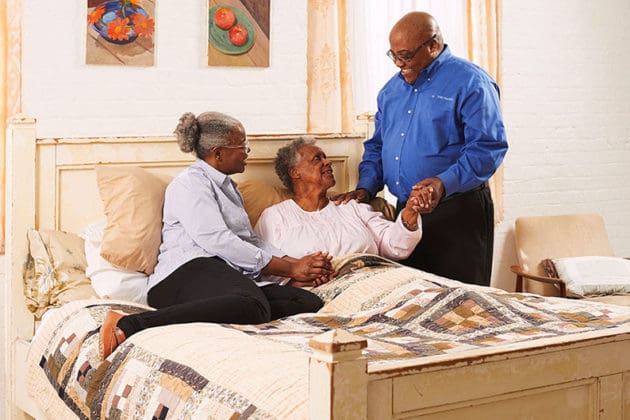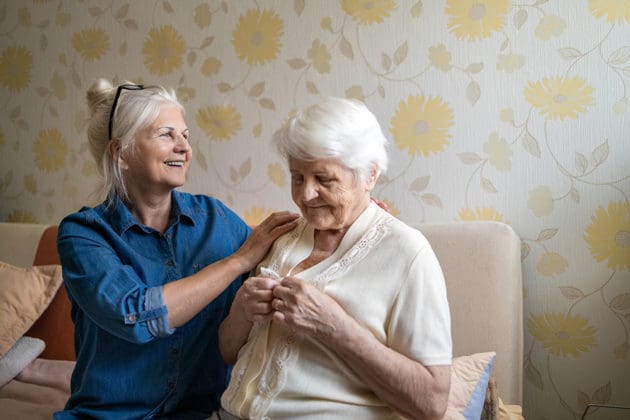
Personal care can be challenging when you can’t get out of bed. But grooming is especially important for bedbound people. Clean skin, hair, and bedding — and even getting dressed — can make your loved one more comfortable and can boost self-esteem.
A home health aide can help by bathing and shampooing your loved one while they are bedbound and can support you until you feel comfortable doing it on your own. If you’re ever unsure of what to do, just ask a nurse or home health aide to demonstrate.
10 Steps for Bathing a Bedbound Person
Bathing cleans the skin, stimulates circulation, and provides movement. Most people do not need a full bath every day, but aim to wash the hands, face, and genital area daily. When you bathe your loved one, uncover and wash one body part at a time, telling them what you are going to wash as you go along. Cover each part again before you move to the next.
- Gather the supplies you’ll need: nonlatex medical gloves, sheet or blanket, basin of warm water, mild soap, two large towels, washcloths, baby oil or lotion (optional), adult brief (if using), clean clothes or gown, and clean sheets.
- Put up the bed rails, or put stable chairs at the side of the bed. This will help prevent a fall. Be sure the chairs don’t slide.
- Close the door and curtains for privacy. Adjust the room temperature if needed.
- Put on the gloves.
- Remove your loved one’s clothes and adult brief (if using). Cover your loved on with the blanket or sheet.
- Place a towel under the body part you are washing. Use a washcloth and a small amount of soap (too much soap can cause dryness). Rinse the body part and gently pat dry — do not rub. Gently massage baby oil or lotion onto areas of skin that are dry.
- Start with the face and work down. Skip the private areas and wash the legs. Roll your loved one to one side to wash their back.
- Wash the private areas and buttocks last.
- Remove all body waste.
- Dress your loved one in clean clothes or a clean gown and change the sheets.
When everyday tasks like cooking, dressing, and bathing become difficult, a home health aide can offer help so your loved one can stay safe at home.
11 Steps for Washing a Bedbound Person’s Hair
Most people don’t need their hair washed every day.
- Gather the things you will need: large trash bag, five to six large towels, kitchen-size garbage bag, 2-gallon basin of warm water, washcloth, plastic cup, mild shampoo, and hair dryer (optional).
- Open the large trash bag. Roll the sides down until the bag looks like a bowl. Line the bag with two or three towels to catch water. This helps keep the bed dry.
- Put the pillow in the kitchen-size garbage bag (as if the bag was a pillowcase) and cover the bagged pillow with a towel.
- Put the towel-lined trash bag under your loved one’s head. Roll up another towel and place it in the bag, positioned under your loved one’s neck.
- Fold the washcloth in half. Place it over your loved one’s eyes. (They may want to hold it in place.)
- Use the plastic cup to wet their hair. Be careful to keep water off their face by covering their forehead with your free hand.
- Gently massage shampoo (a portion no larger than a quarter) into the hair and scalp. Lift the head gently to massage underneath.
- Rinse the hair with cups of clean water until all traces of shampoo are gone.
- To remove the large trash bag, carefully unroll the sides, keeping the water inside the bag. After removing the water-filled bag, replace it with the towel-covered bagged pillow to support your loved one’s head.
- Gently pat dry the hair with a towel, or use a hair dryer on low. When the hair is dry, remove the towel from the bagged pillow and take the pillow out of the bag.
- If needed, gently comb or brush the hair.
14 Steps for Changing Sheets Around a Bedbound Person
When your loved one spends most of their time in bed, changing the sheets at least once a day is important for cleanliness and comfort.
- Gather the things you will need: two clean flat sheets (not fitted), bed pad (if using), blanket, pillowcases, and a plastic bag.
- Put the bed rails up, or put stable chairs at the side of the bed. This will help prevent a fall. Be sure the chairs do not slide.
- Imagine the bed divided in half lengthwise. Roll your loved one to the side of the bed away from you.
- Untuck the dirty sheet from under the mattress on your side. Roll it lengthwise toward the center of the bed until the roll rests against your loved one’s back.
- Take a clean flat sheet and fold it in half lengthwise. Put it on the bed with the fold running down the center of the bed.
- Roll the top half of this sheet to the center of the bed. Tuck the unrolled half of the sheet under the mattress. Be careful to smooth out any wrinkles.
- Add a bed pad (if using): Fold the pad in half, put the fold at the center of the bed, and roll the top half of the pad to the center of the bed.
- Roll your loved one so that they are lying flat on their back in the center of the bed (they will be lying on top of the rolls).
- Move the chairs (if using) to the opposite side of the bed.
- Roll your loved one so that they are on the half of the bed covered by the clean sheets.
- Remove the dirty sheets completely and put them in the plastic bag.
- Unroll the clean bottom sheet and bed pad (if using) from the center of the bed. Stretch out the sheet and smooth out any wrinkles. Tuck the sheet under the mattress.
- Cover your loved one with the second sheet. Tuck it in and add a blanket if they prefer.
- Change the pillowcases and adjust the pillows.
8 Tips for Helping a Bedbound Person Get Dressed
Getting dressed for the day provides a normal routine and helps your loved one maintain their dignity.
- Dress your loved one in everyday clothes for as long as possible — a time may come when it will be better to use a hospital gown.
- Choose clothes that are easy to put on and take off. Look for clothes with snaps, zippers, Velcro, drawstrings, or elastic waistbands. Shirts with loose necklines will also help.
- If your loved one can choose their outfit, let them. Give two or three choices to pick from.
- Be flexible. Wearing a bra or hat may not be important.
- Let your loved one dress themself as much as possible. Hand them one item of clothing at a time.
- If they have a weak side, put the clothes on that side first. When undressing, take the clothes off the weak side last.
- On some clothing, buttons can be replaced with Velcro. Attach zipper pulls to the metal tabs of zippers, or use a large paper clip.
- If your loved one wears shoes, choose slip-on shoes or ones with Velcro closures. Use extended shoehorns if necessary.


